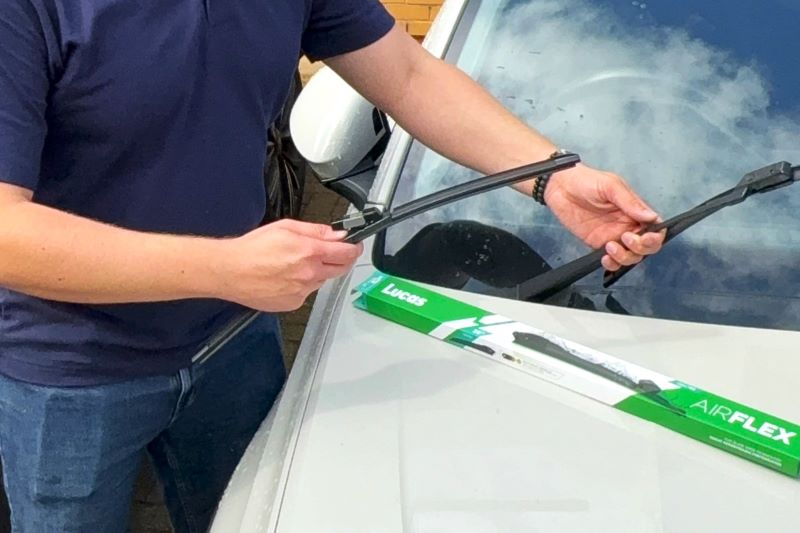Wiper Blades Innovations That Take a Swipe at Convention

Here’s a fun fact for you: Did you know the humble windscreen wiper was invented way back in 1903?
Not only that, the basic concept of the first ‘windshield wiper’ has changed remarkably little ever since.
Proving that the simplest ideas can often be the best – no matter the era - it’s a testament to the logical genius of windscreen wipers that the original function of a lever and oscillating arm forms the basis for designs even today.
That’s not to say others haven’t had a good go at revolutionising how windscreen wipers operate and function over the past century, leading to some curious innovations in that time – some certainly better than others!

Monoblade
A manufacturer that prides itself on being at the precipice of motoring innovation, Mercedes-Benz turned its attention to wiper blades in the 1980s and promptly created the so-called ‘Monoblade’.
Comprising of a single centrally mounted wiper blade, the Monoblade was developed with the intention of reaching farther into the edges of the windscreen than conventional designs.
It achieved this with a mechanism that actively allowed the arm to extend out when swiping across the sides of a windscreen but then retracting in as it wiped the top of it.
The innovation helped to solve that age-old problem of how to clear a rectangular windscreen in a single motion. It was certainly effective on the handful of Mercedes models that the Monoblade appeared on, but it was also ostentatiously complex for quite a simple outcome.

Pantograph Wiper Blades
What do the Toyota Aygo and Renault Twingo have in common with the McLaren MP4-12C and Lamborghini Murcielago? Not a lot, if anything, you’d think…
And yet, when it comes to wiper blades they actually share an application of a geometry used very rarely on cars – the single pantograph wiper.
These comprise a large single wiper on two linked arms that create a parallel sweeping motion (similar to a human pantograph, hence the name).
More commonly found on ships or commercial vehicles, the mechanism is handy for cars with a windscreen set at an unconventional gradient.

Hidden Wiper Blades
One of the more unusual features of the SEAT Altea when it was launched in 2004 was the way the wiper blades were housed at the edge of the windscreen rather than at the foot of it.
Intended to complement the Spanish model’s curvy lines, the wiper blades rested in the upright position tucked into gaps within the A-pillar. While it made them a pain to get to when it came to changing them, it did also shield them from the elements and improved aerodynamics.
It was a tactic SEAT would employ for the Toledo and Leon around the same time but has since abandoned the technique.

Three Wiper Blades
Sometimes style rules over substance, which goes some way to explaining why three wiper blades would end up on the front windscreen of the Toyota FJ Cruiser.
A retro-themed SUV popular in the United States, the FJ Cruiser is brimming with quirky design traits that throwback to off-roaders of yesteryear with their chunky bodywork and letterbox windows.
Unfortunately, while a wide shallow windscreen might look cool, it’s a pain to clean. Not to worry, Toyota would get around this by installing three small wiper blade arms that each serve to clean their portion of the windscreen.

Twin Rear Wiper Blades
Another example of how a manufacturer refused to let boring functionality triumph over more exciting form, MINI had to think outside the box when it launched the quirky Clubman estate.
A car drenched in heritage, while the Clubman’s styling was faithful to the original, in doing so it presented a few issues for it to conform to modern safety standards.
This included how to approach installing wiper blades to the barn-style rear doors which opened from the centre, much like a van. However, unlike a van, these doors had windows and thus a legal stipulation that they had wiper blades too.
The result is a rather ungainly pair of tiny wiper blades that shift just enough moisture from the rear windows to make the grade.

Linear Wiper Blade
While linear wiper blades aren’t a new invention, to date no production car has attempted to adopt this style of windscreen wiping.
Indeed, the mechanism – which uses a full-length wiper blade to sweep from one edge of the windscreen to the other – is common on ships and boats, but then life tends to move around you a little slower on the open sea.
By contrast, there is little hope of developing a linear wiper blade that could move fast enough to clear a car’s windscreen in heavy rain.
That’s not to say it hasn’t appeared on a car, however. Indeed, Lancia and Bertone dabbled with the idea on the 1978 Sibilo concept car revealed at the Turin Motor Show – but that’s as far as it got.

AquaBlade
Bringing things right up to date, Swedish parts maker Valeo introduced the clever AquaBlade to its range in 2012.
The AquaBlade uses a flat blade with small laser-cut holes that allow washer fluid to be distributed along the entire length of the blade.
A selection of cars use Valeo’s AquaBlade technology, including the Mercedes SL-Class, the Alpine A110 and Volvo XC60.

Rain-Sensitive Wiper Blades
While many of today’s modern cars are equipped with wiper blades that come on automatically when moisture is detected, the origins of rain-sensitive windscreen wipers go right back to the 1970s.
First debuting on the Citroen SM in 1970, rain-sensitive windscreen wipers were just one of several pioneering features of the French luxury model.
And yet, despite the mechanism working remarkably well considering the era it first appeared, it would take decades for the technology to become commonplace in the automotive industry.
Top Brands, Great Value Wiper Blades
With WindscreenWipers.co.uk's registration search tool, you will only get results for wiper blades that are guaranteed to fit your vehicle, all at great value prices, even among top name brands like Bosch, Michelin and Lucas.
Plus, with our easy-to-follow fitment videos and expert guidance, you can install them in under a minute—keeping your windscreen spotless with minimal effort.


